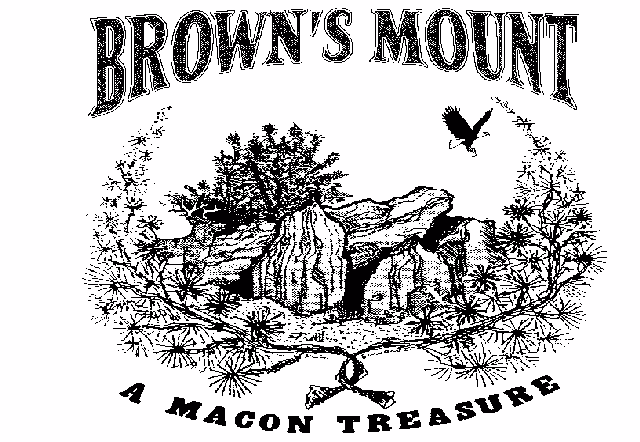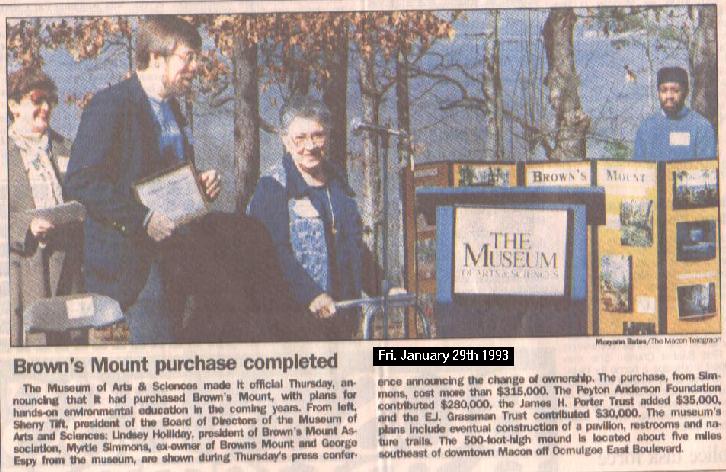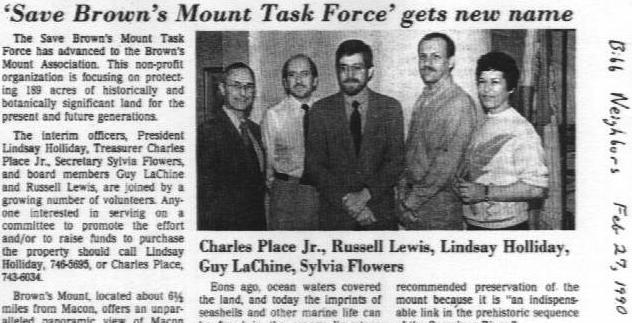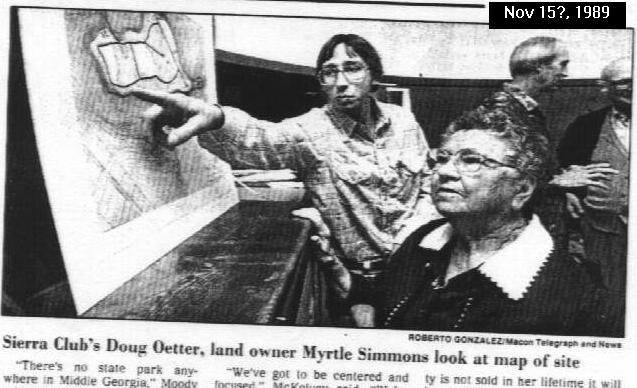
Brown's
Mount Association
| ---on Facebook--- - Articles and Bylaws - Archaeology - Timbering in 2007 - Telegraph articles 1-19-08 - Tornado Damage limits access 7-21-08 2009 Updates 2010 Updates 2011 |


Around
the Mount is the Bond Swamp National Wildlife Refuge - parts of
which still appear timeless, primordial.
| Brown's Mount Association's outgoing president, Lindsay Holliday congratulates John Wilson and other new board members. Pictured are [L-R] Dee Hansford , Mick Allen, Holliday, Wilson, Betty Rose, all standing at the Macon Overlook atop Brown's Mount after elections on May 23rd. Other directors not pictured are Brian Adams and Ron Richards. [click here for bigger image] |
| |
 |
|
|
Brown’s Mount is a 189
acre ecological feature that rises steeply above the
Ocmulgee River basin just south of the City of Macon,
Georgia. It forms the northeast boundary of Bond Swamp
National Wildlife Refuge and is managed by the U.S. Fish
and Wildlife Service. This tract re opened to public
access in the summer of 2010. Questions about Browns Mount
should be directed to the Refuge office at 478-986-5441. History of Brown’s Mount Brown’s Mount is named for its original owner George A. Brown. However the importance of this site to the region comes from its lengthy history of human occupation. The site was occupied ca. 950-1000 A.D. Brown’s Mount is a contributing property to the Ocmulgee Old Fields, a well-documented traditional cultural property associated with the Creeks. The Creeks established a number of towns on the Ocmulgee River in the late 17th century. Although these towns were abandoned by 1730s, the area continued to play an important role in Creek culture and trade. The Creeks were pushed from this land by English and American settlers by 1835. In the early 1800’s Daniel and Nancy Moon Rogers lived here. Their family cemetery is still on the northeastern side of the Mount. In 1840’s Charles Lyell came to research and document the surrounding environments. In 1846, Lyell called Brown’s Mount a place of “great siliceous casts of fossil shells and corals… that belong to the Eocene Period.” The famous central Georgia poet, Harry Stillwell Edwards built a writing cabin on the Mount in 1918 calling it “Mt Talemeco”. He is believed to have written the famous poem, “On the Mount”, from his cabin during the first World War as he listened to the soldiers below at the military training base, Camp Wheeler. His cabin burned down in the 1950’s but its chimney and foundation can still be seen on the top of the Mount. Browns Mount was bought by Myrtle and Henry Simmons in 1938. Mrs. Simmons farmed the land until her husband died and then she sold the property to the Macon Museum of Arts and Science in 1993 with the understanding that it would be preserved and not commercialized. The Georgia Department of Natural Resources, through the River Care Funding, purchased the property in 2000 and designated it as a Natural Heritage Preserve. Through a management agreement between the State of Georgia and the U.S Fish and Wildlife Service, 165 acres of Browns Mount became part of Bond Swamp National Wildlife Refuge in July 2006. More information on cultural and historic preservation for the U.S. Fish and Wildlife can be found at http://www.fws.gov/historicpreservation and http://www.fws.gov/bondswamp and http://www.fws.gov/bondswamp/pdfs/BrownsMountHistory.pdf |
||

 |
|
February 27th 1990 - Even the longest journey begins with but one, first step... |
|
from the Macon Telegraph - 11-15?-1989 |
 |
| State
agency
buys
Brown's
Mount property from museum
|
||
|
By James Palmer - The Macon Telegraph - March 30, 2000
The Trust for Public Land announced Wednesday the Georgia Department of Natural Resources has purchased 165 acres of Brown's Mount from the Museum of Arts & Sciences. The trust facilitated the purchase. Norma Casal Buckley, a project manager for the trust, said the deal was closed March 17. Brown's Mount will be used as an educational center as part of the Bond Swamp National Wildlife Refuge. The DNR will lease Brown's Mount to the U.S. Fish and Wildlife Service, and the museum has agreed to conduct environmental education programs on the mount. All proceeds of the sale have been committed by the museum toward enhancing its programming. Museum director Michael Brothers said the land was bought for more than $300,000. He said it is the culmination of more than a year and a half of negotiations. "It's not a new development, but it has taken awhile to iron out the specifics," Brothers said. "It became a pretty complicated thing." He said it's a great opportunity for the museum because it capitalizes on its strengths. "The state takes over administration of the site, and we're going to be able to do more environmental education," Brothers said. Bond Swamp National Wildlife Refuge was opened for public fishing March 15. Foot trails should be available to the public by mid-October. The refuge covers about 6,500 acres on the eastern banks of the Ocmulgee River and is just east of downtown Macon. The Nature Conservancy acquired Bond Swamp in the early 1980s. The Trust for Public Land has negotiated acquisitions of more than 1,700 acres on the west bank of the river in connection with the Ocmulgee Heritage Greenway initiative. "Bond Swamp we're thinking about as the conservancy area of the greenway. It's a place people can go and learn about all of the resources there," Buckley said. "Brown's Mount is the perfect place to have a trail-head. You can see all of Bond Swamp from the top and then you can turn around and see the skyline of Macon. It's a fantastic place." Brown's Mount, which is about 500 feet high and is located off Ocmulgee East Boulevard, is one of the highest points near Macon. It was a favorite picnic spot for Macon residents in the 1800s and was once the home to Harry Stillwell Edwards, noted local poet who died in 1938. About 10 years ago a group organized and began efforts to buy the land because it was being considered for development. The museum purchased the land in 1993. "Hopefully, this is the final step that will protect it forever," said Buckley. By James Palmer - The Macon Telegraph - March 30, 2000 |
||
| |
http://www.macon.com/mld/macon/living/14772300.htm Posted on Sun, Jun. 11, 2006 Page 1F with color pics Brown's Mount offers nature's wonder, spectacular views By Rodney Manley TELEGRAPH STAFF WRITER As breathtaking as the view may be from atop Brown's Mount, its beauty is perhaps best beheld while trekking the seven miles of trails that climb 500 feet above sea level. For it's on those paths that the limestone-capped mount hints at its rich past. Fossil deposits in the cliffs and rocks remind hikers that this was prehistoric shoreline. A wave of raised earth runs near the western slope, the remnant of wall dating back hundreds, possibly thousands, of years. The mount is home to varied populations of plants and animals, including endangered species. Once threatened by development, Brown's Mount, a former farm, writer's retreat and Indian settlement, has been an education center since its purchase in the early 1990s by the Museum of Arts and Sciences. The museum sold the property to the state in 2000 but continues to conduct programs there. It offers day and night hikes up the mount on the third Saturday of each month. The hike next Saturday might be the last chance to see Brown's Mount for a while. The museum normally halts the hikes in July and August because of the summer heat, and just when the hikes will resume is unclear. The U.S. Fish and Wildlife Service, which manages the nearby 6,500-acre Bond Swamp refuge, is on the verge of signing a deal to take over management of Brown's Mount from the state. The museum has no agreement with the federal agency, but Fish and Wildlife officials say their deal with the state should mean even more public access. "We'll be looking at different types of opportunities to open this up to the public," said deputy refuge manager Carolyn Johnson, who led a team up the mount last week for a public use review. The Brown's Mount property, which now is gated, might be opened all the time for hiking, hunting, bird-watching, wildlife photography, field trips and other uses. There are no plans to staff the site, she said. At the base of Brown's Mount, where the hike begins, young longleaf pines - which once dominated the south Georgia countryside - struggle to gain a foothold. Several have lost their crowns, which does not bode well for their survival. The path steepens and a small cliff jutting from the hillside comes into view, giving hikers their first look at the layers of limestone and clay that form the mount. "It's sort of like a birthday cake," said Andrew Blascovich, the guide on many of the museum hikes. The Georgia lobed spleenwort, a small, rare endangered fern, sprouts from cracks in the limestone boulders along the mount's eastern slope. The rise finally reaches a plateau where Indians once dwelled and where Myrtle Simmons, thousands of years after the first settler, farmed while her husband was away working for the railroad. Here, an overlook offers a gaze across the Ocmulgee River and over the city of Macon. The hikers head off, and a deer leaps off the old farm road and into the cover of trees. On another day, one might encounter rabbits, turkey, beaver, even a black bear or bald eagle. "Almost every animal you think of in Georgia comes to Brown's Mount," said Blascovich. "It's a safe haven from the swamp when it floods." Nearby, the hikers find the site where poet and novelist Harry Stillwell Edwards sought solitude for his writing. A chimney of limestone rock is all that remains of the cabin where he penned his collection of poems "On the Mount." Closer inspection reveals a sand dollar in one chimney rock. The cabin was burned down accidentally by Boy Scouts in the 1960s, Blascovich said. "They had a jamboree, and the jamboree got a little out of hand." Archeological studies have uncovered two American Indian houses, an earth lodge and small mound similar to those at the Ocmulgee National Monument. Naturalist William Bartram made note of the mound during his travels through the state in the 1770s. The settlement was probably surrounded by a wall of 3 feet of stone stacked on a raised dirt base. The wall probably kept livestock in while helping keep intruders out, Blascovich said. "Ocmulgee was the center city, and this was one of the suburbs," he said. The trail along the southern slope of the mount hugs a sharp, 20-foot cliff overlooking a field of boulders. A short distance away, on refuge property, another cliff offers a grand look across Bond Swamp. A "bowl" is carved into the large, flat rock, where ancient residents sat and ground corn while taking in the view. IF YOU GO What: Day and night hikes up Brown's Mount When: 10 a.m. and 8 p.m., Saturday, June 17, 2006 For more information: Call the Museum of Arts and Science at 477-3232 for details and directions. To contact Rodney Manley, call 744-4623 or e-mail rmanley@macontel.com |
|
page maintained by - Lindsay Holliday